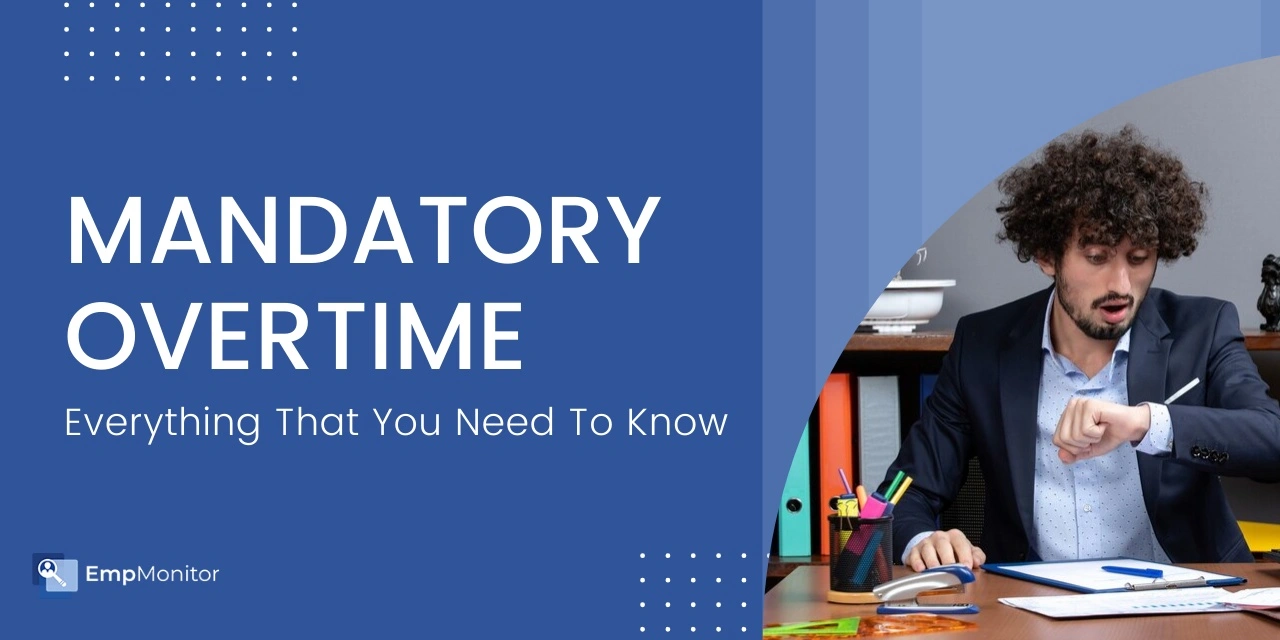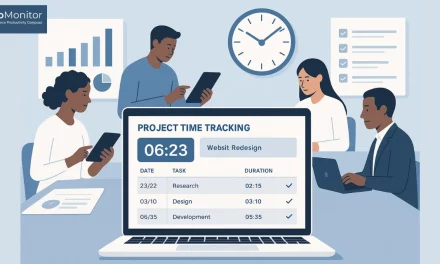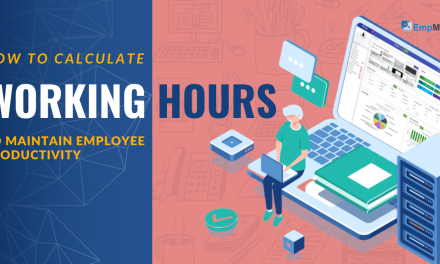Most business owners prefer not to ask their staff to work overtime. But, there are situations when it is required when an unforeseen circumstance arises. It’s critical to discuss the issue of whether mandatory overtime is legal to prevent miscommunications with your employees.
Employees who are unaware of mandatory overtime laws may believe they have the right to refuse overtime work because labor laws forbid it.
On the other hand, you can be a busy boss who finds it difficult to persuade staff members to work overtime. You don’t know much about mandatory overtime, and you believe that you have no legal options.
It is a reality that employers have the authority to require overtime from their staff, and that failure to comply with this requirement may result in termination. However, there are government agencies responsible for overseeing labor and overtime, and measures exist to minimize the need for forced overtime.
Let’s delve into the blog and understand what mandatory overtime is and whether work overtime is legal or not.
Listen To The Podcast Now!
What is Mandatory Overtime?
Mandatory overtime describes the practice of companies forcing their employees to work longer shifts than usual, frequently going above and beyond the 40-hour norm. There are several reasons why this might happen, including strong demand, a lack of employees, or approaching deadlines.
Benefits
Mandatory overtime has several advantages.
- It first ensures that every worker has the chance to put in the necessary number of hours each week. It is crucial because it guarantees that no one is unjustly burdened with more work and everyone is treated equally.
- Employers may also ensure they have enough workers on hand to satisfy demand. This is particularly crucial when things are busy or there is a staffing shortfall.
- Thirdly, it facilitates more income for workers. This is because overtime hours are normally compensated at a rate of time and a half for employees.
- Fourthly, it gives employees the chance to learn about many company facets. This is significant since it aids the knowledge and skill development of personnel.
- Lastly, it enables employers to reach their output targets. This is crucial since it contributes to the company’s success.
To streamline this process and ensure that tasks are evenly distributed, employers can rely on EmpMonitor, a powerful employee monitoring tool. With features like time tracking, task management, and productivity insights, EmpMonitor helps businesses stay on top of their workforce’s performance, making it easier to balance workloads, improve efficiency, and meet deadlines with ease.
Is Mandatory Overtime Legal?
It is legal to require employees to work overtime, and they are generally unable to refuse to do so. There is a simple requirement for employers to pay the minimum wage for normal hours and overtime rates when an employee works more than 40 hours per week. There are no restrictions on the number of overtime hours an employee may work.
Nonetheless, there are several situations in which employers are not allowed by law to require employees to work overtime. Let’s examine a few instances.
Not If You Have a Family Emergency
If an employee is on leave due to a familial or medical emergency, their employer cannot legally ask them to work extra.
A qualified employee is entitled to up to 12 weeks of unpaid leave each year, as well as benefits and the guarantee that they will be able to return to their previous position or one comparable when their leave expires. It implies that they are not required to work extra when on vacation.
Not If It Violates The Terms Of an Employee Contract
An employee may be able to sue their employer for damages for breach of contract if the company violates the terms of an employment contract. It is also possible for a contractually binding handbook that explicitly states their policy regarding extra hours and working after hours.
Remember: It’s more typical for employers to demand hourly workers read and sign an employee handbook than the employment contracts that salaried administrative, executive, and professional staff members sign.
However, employers can create employment contracts for hourly workers or incorporate legally enforceable text with an employee signature at the end of employee handbooks. Both employers and workers must understand the legal implications of their employment contract, particularly about overtime vs comp time provisions.
Not If It Poses a Health or Safety Hazard
Mandatory overtime is prohibited if it risks employees’ health or safety or violates general workplace safety laws.
Authorities can cite an employer for a violation if all of these elements are present:
- The employer failed to keep the workplace free of a hazard to which employees were exposed.
- The hazard was recognized.
- The hazard was causing or was likely to cause death or serious physical harm.
- There was a feasible and useful method to correct the hazard.
If an employee believes that mandatory overtime puts dangerously exhausted workers at risk, they may register a complaint. This complaint can lead to an on-site inspection by the appropriate authorities. This occurs if the employer does nothing to prevent the risk once it is raised.
Not If You Inadequately Compensated for Overtime Work
If employers fail to provide enough compensation to their employees, they may be subject to illegal obligatory overtime. Employers occasionally implement an overtime pay threshold for non-exempt workers who truly qualify for overtime or make typical wage mistakes.
Workers may not be receiving the necessary overtime pay if their employer has
- Incorrectly designated them as exempt workers: According to regulations, employees must pass three tests to be exempt from overtime pay. First, their duties must be administrative, executive, or professional. They also must be paid a salary, which cannot be less than a specified minimum amount.
- Overtime money withheld due to poor work: Only in cases where an employee misses two or more days of work due to illness, disability, or vacation leave may an employer withhold payment from their salary. Pay deductions are another option for employers in cases of serious safety violations or employee suspensions due to misconduct.
- Employers Must Pay for Breaks: Paid for rest periods withheld to avoid paying overtime. Employers must pay employees for 15- or 20-minute breaks if they work a specific amount of hours each day.
- No Overtime for Training: not compensated for overtime for required in-office training.
Not If You Are a Union Member
Under labor laws that protect unionized workers, employers may be restricted from enforcing mandatory overtime if there is a collective bargaining agreement in place that addresses overtime arrangements with employees.
Even in non-union workplaces, the majority of workers have the freedom to band together, exchange information, sign petitions, and pursue unionization as a means of obtaining better pay and working conditions.
Employers must meet with unionized workers to engage in “good faith” negotiations over pay, hours, and working conditions, including talks about needed overtime if the workers decide to form a union to represent them in a collective bargaining agreement.
Also Read:
4 Methods For How To Keep Track Of Employee Hours
Working Overtime: How To Know It Is Working For You?
How To Avoid Mandatory Overtime: Tips for Employers
Mandatory overtime has certain advantages for businesses, but it can also have a lot of drawbacks. For example, employers may have to deal with increased costs as a result of higher overtime rates. For this reason, it’s critical to think about replacing required overtime with more effective alternatives and having proper overtime management plans in line.
Here are some tips to assist you in preventing your staff from being made to stay late at work.
Tip #1: Post shifts that are available for overtime.
Posting overtime shifts and allowing employees to select when to put in extra hours is one of the best ways to avoid requiring overtime. Instead of putting in more hours, they can volunteer for overtime thanks to this chance.
Some employees might put in more hours if they can finish the project before the deadline or if they just want to get paid more.
For whatever reason, giving people the freedom to make their own decisions makes the workplace happier.
As a result, employee retention will increase, and they will be grateful for the opportunity to make more money.
Tip #2: Reassess the workload of the employees
Employees may have to put in extra hours to complete tasks if they are overworked. Constant overtime, however, might be harmful because it frequently jeopardizes employee health. Overworked workers take on more duties and obligations than their position permits, which increases their risk of burnout, mental tiredness, and workplace accidents.
For example, employees could find it challenging to give each project the proper amount of time and attention if they are working on multiple projects at once,
Employers should allocate coworker’s responsibilities based on urgency to prevent situations like this one. They won’t have to plan many overtime shifts thanks to this.
Tip #3: Have preliminary conversations with your Employee
Employees who get clear communication are better equipped to contribute to the success of the firm.
Therefore, it’s best to schedule a meeting with staff members when overtime shifts are required and let them know that scheduling work overtime was not a decision made lightly.
Inform them of the importance of their work in managing the surge in demand during peak periods or when a special project is approaching. In this manner, you will draw empathy more readily and your staff will be more eager to assist you in getting through the busiest time of year.
Establish an environment of open communication where people feel free to express their opinions on working long hours rather than requiring overtime work. Ensure to provide incentives that combat burnout, including additional break time or bonus paid time off (PTO) when the hectic season ends, if you notice signs of burnout in your staff.
Tip #4: Bring on temporary or part-time staff
Employee shortages affect every organization eventually, and they are typically caused by:
- Sick days of employees,
- well-earned vacations,
- a spike in client demand at busy times of the year, or
- a unique project that needs to be completed quickly.
Employing temporary or part-time workers to manage the extra work is the greatest way to prevent employee burnout brought on by excessive overtime during busy times. Actually, rather than paying overtime, it could be preferable to hire temporary or part-time staff.
Tip #5: Minimize distractions at work
Distractions at work happen to everyone at least once a day, if not more frequently. Interruptions, like unforeseen meetings or constant emails, might be beneficial at times, but they can also cause a worker’s productivity and concentration to falter, making it more difficult to finish tasks on schedule. This may lengthen the time required for them to finish their tasks, necessitating the need for overtime.
However, there are a few things you can do to solve this issue. For example, you may rent a closed office space rather than an open one or relocate your employees’ workstations to a more peaceful location.
Additionally, communicate meeting schedules ahead of time to avoid interfering with an employee’s workflow.
You can let your staff members know that they can choose a specific time slot for checking and responding to emails and that they are not required to respond to them right away.
Apart from this, you can also use workforce management tools or project management software to manage your employees’ workload and improve their productivity. It will help you to efficiently optimize the workflow. Moreover, it allows you to track employee time, helping you to get a clear picture of their working hours and overtime. One of the best workforce management software is EmpMonitor. Let’s have a detailed look at this powerful tool.
EmpMonitor – The Best Workforce Management Software
EmpMonitor is a robust and reliable employee monitoring tool that can monitor your workforce, helping you track the employees’ computer activity.
With over 500k+ employees tracked across 100+ countries, EmpMonitor serves its features across various business aspects like IT Industry, Banking, Healthcare, Education, etc.
It provides some key features like monitoring team performance, managing a distributed workforce & enhancing security measures that help increase productivity at work.
Considering the necessity of project outline, EmpMonitor offers a variety of features:
Project Management
EmpMonitor helps you to assign tasks to your team, monitor their work, and manage the entire project from start to end. It lets you get a clear picture of the project work, ensuring the team is productive and in the right direction.
For mandatory overtime, EmpMonitor offers features like:
Customized Access Level – It offers customized access levels for every member, guaranteeing they have just the appropriate amount of access.
Role Assignment – EmpMonitor helps you assign individuals to specific roles that clearly define their tasks and talents.
Member Groups– You can divide the team members into groups to streamline the cooperation and communication for smooth operation.
Timeline Monitoring– For ultimate project control, EmpMonitor lets you monitor the whole duration of your project, documenting task creation, modifications, and completions.
Task Handling and Subtask Creation: This workforce management software manages tasks with CRUD(Create, Read, Update, and Delete) operations effortlessly, including fetching, searching, filtering, and generating reports.
Moreover, it breaks down the tasks into subtasks for unparalleled project control and tracking, ensuring no detail is overlooked.
Shift Management
EmpMonitor’s Shift Management feature streamlines how you oversee employee shifts. It allows you to track shift schedules, monitor attendance, keep track of employee work hours and manage shift changes all in one place that is required for mandatory overtime. You can view real-time data on who is working and when making it easier to ensure coverage and optimize staffing. This feature helps you manage shifts efficiently, maintain accurate records, and make informed decisions about workforce allocation.
Guess what, EmpMonitor is not just limited to these features. It has more amazing features like time tracking, user activity tracking, insider threat prevention, attendance monitoring, etc. These features are worth it and can enhance your workforce management.
Conclusion
Navigating the rules of mandatory overtime is crucial for both employers and employees. Employers can have mandatory overtime when necessary, but it must comply with legal standards. Employees have rights regarding when overtime can be enforced and under what conditions. Knowing these rights can prevent misunderstandings and ensure fair treatment in the workplace.
Utilizing tools like EmpMonitor can also aid in managing workload and productivity efficiently. Ultimately, understanding and managing mandatory overtime is essential for fostering a compliant and productive work environment.

















